Digitalisation of Manufacturing Systems: A Literature Review of Approaches to Assess the Sustainability of Digitalisation Technologies in Production Systems
Abstract
:1. Introduction
2. Background and Scope of the Research
2.1. Digitalisation Technology in Manufacturing Systems
2.2. Sustainability as an Assessment Criteria for Digitalisation Technologies in Manufacturing Systems
2.3. Research Questions
- RQ 1: What is the importance of “digitalisation technologies (DTs and CPSs) and sustainability” in production environments in research?
- RQ 2: Which subjects are discussed in terms of “digitalisation technologies (DTs and CPSs) and sustainability”?
- RQ 3: How is the sustainability assessment of digitalisation technologies (DTs and CPSs) discussed in research?
- RQ 4: Which approaches exist to assess the economic and environmental benefits of digitalisation technologies (DTs and CPSs) in manufacturing systems?
3. Methods
3.1. Literature Review
3.2. Data Collection and Analysis
- (1) Identification: In the first step, the search terms are defined. Based on the research questions, these terms focus on cyber–physical production systems (CP(P)Ss) and digital twins (DTs) in the production environment. To ensure no relevant literature is missed, no further restrictions were imposed regarding environmental or economic assessment. Therefore, the literature search used the terms “digital twin”, “cyber-physical (production) system” and “manufacturing” and connected them to the search terms (ALL = (manufacturing production “digital twin*”)) and (ALL = (manufacturing production “cyber physical system*” “cyber physical production system*”)) (used queries in “web of Science”: Query 1: manufacturing production “digital twin*”, Query 2: manufacturing production "cyber physical system*" “cyber physical production system*”).
- (2) Screening: In the second step, duplicates are removed and the remaining search results are filtered. To identify the articles that are relevant to the research problem, the titles and keywords of the papers are analysed first. All papers that obviously deal with another topic are excluded (no production background). Further, the abstracts of the remaining research results are analysed and assigned to the categories Industry 4.0, digital twins and cyber–physical systems (including CPPSs). Papers with another I4.0 background (Big Data, AI) are excluded. To identify and categorise the literature that deals with the cost and resource efficiency assessment of digitalisation technologies in production systems, the categories environmental and economical are added. Publications were considered that address environmental or economic issues in the context of CPSs or DTs. From this, papers can be derived that basically deal with the use of digitalisation technology to increase cost or resource efficiency. These categories are necessary to study the importance and dynamics of the research subject related to the search term (RQ 1 and RQ 2). These publications are classified according to the year of publication, the type of publication, the journal category (engineering, environmental, computer and other sciences), the most important journals, the frequency of keywords, the regions (countries) and the most important universities (institutes) of the publications.
- (3) Eligibility: In the third step, the existing methods for holistic assessment are filtered out of these results and evaluated in terms of whether they deal with (i) a holistic approach for an economic and/or environmental assessment, (ii) efforts (costs) and benefits associated with digitalisation technologies, (iii) a specific economic assessment and (iv) a specific environmental assessment (RQ 3). In addition, the cross-references of the literature examined are analysed in a snowball search and included in the LR. This is carried out based on the relevant literature, as it is assumed that other relevant literature is mentioned there. As a result, various subject fields are characterised to determine the relevance of the sustainability assessment of digitalisation technologies in research.
- (4) Selection: In the fourth step, the papers that meet the criteria are analysed in terms of content in relation to RQ 4 to identify the methods used for a holistic assessment of digitalisation technologies. It is essential to describe the status of the methods presented and to analyse them with regard to the consistency of the approach from problem description to decision-making. Other criteria are whether the assessment includes the entire life cycle from cradle to grave in the assessment methodology and whether it takes into account different impact categories and linear/non-linear cost–benefit functions. It is also of interest whether common assessment methods are applied and whether these consider economic and environmental sustainability dimensions.
4. Results
4.1. Quantitative Results
4.1.1. Identification and Screening Results
4.1.2. Chronological Development, Type and Journal of Publications
4.1.3. Keyword Analysis
4.1.4. Publications per Country and Organisations
4.1.5. Characterisation by Subject Fields
4.2. Qualitative Results
4.2.1. Content Analysis
4.2.2. Analysis of the Assessment Methods
5. Discussion
5.1. Importance of Digitalisation Technologies and Sustainability in Research
5.2. Research Subjects in the Field of Digitalisation Technologies and Sustainability
5.3. Sustainability Assessment of Digitalisation Technologies in Research
5.4. Approaches for the Economic and Environmental Assessment of Digitalisation Technologies
6. Conclusions
Author Contributions
Funding
Data Availability Statement
Conflicts of Interest
Appendix A
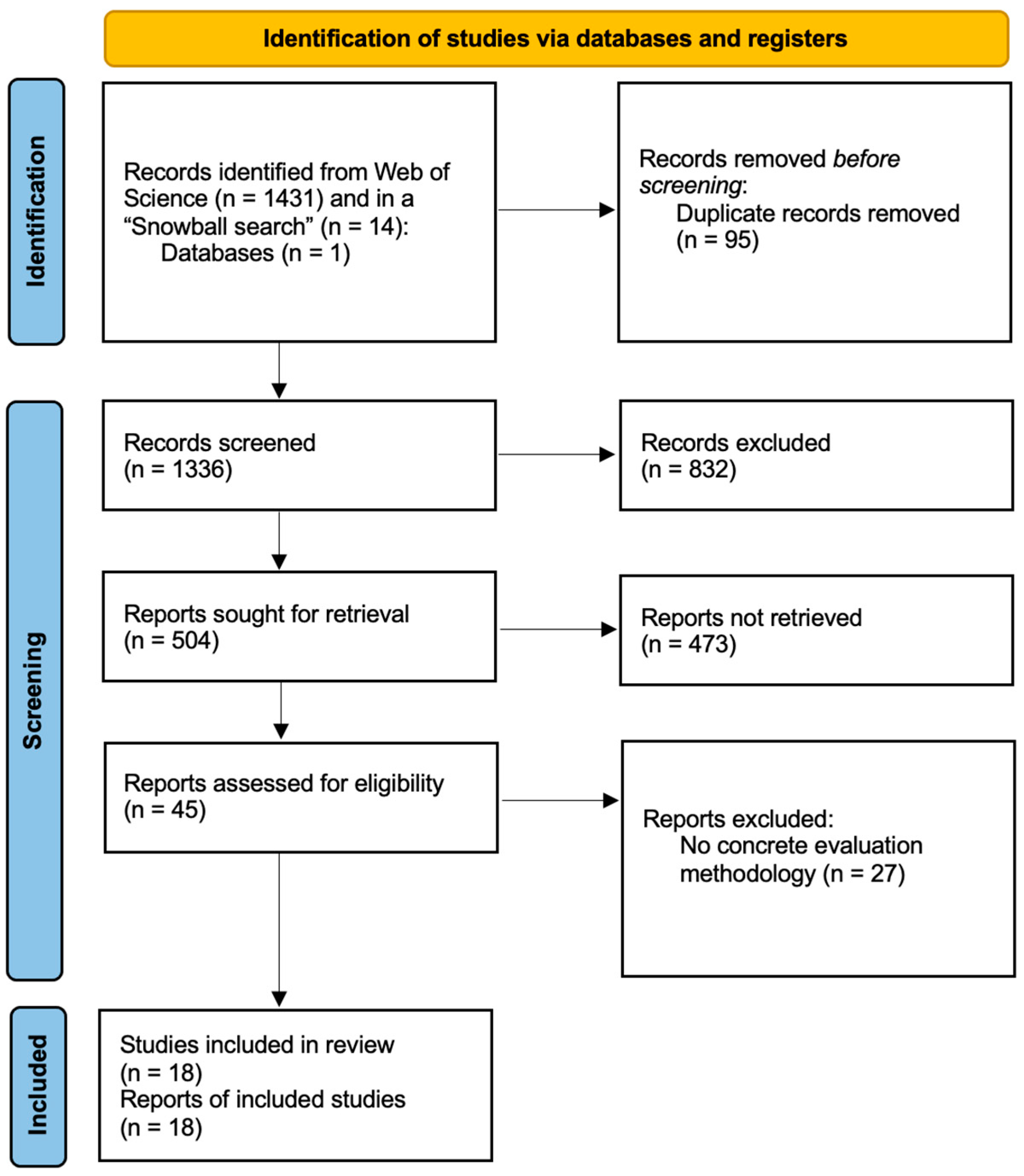
References
- Sartal, A.; Bellas, R.; Mejías, A.M.; García-Collado, A. The sustainable manufacturing concept, evolution and opportunities within Industry 4.0: A literature review. Adv. Mech. Eng. 2020, 12, 1687814020925232. [Google Scholar] [CrossRef]
- Kumar, R.; Singh, R.K.; Dwivedi, Y.K. Application of industry 4.0 technologies in SMEs for ethical and sustainable operations: Analysis of challenges. J. Clean. Prod. 2020, 275, 124063. [Google Scholar] [CrossRef] [PubMed]
- Biedermann, H.; Topic, M. Digitalisierung im Kontext von Nachhaltigkeit und Klimawandel—Chancen und Herausforderungen für produzierende Unternehmen. In CSR und Klimawandel; Sihn-Weber, A., Fischler, F., Eds.; Springer GmbH: Berlin/Heidelberg, Germany, 2019; pp. 41–62. [Google Scholar]
- Dillinger, F.; Bernhard, O.; Kagerer, M.; Reinhart, G. Industry 4.0 implementation sequence for manufacturing companies. Prod. Eng. 2022, 16, 705–718. [Google Scholar] [CrossRef]
- Klimant, P.; Koriath, H.-J.; Schumann, M.; Winkler, S. Investigations on digitalization for sustainable machine tools and forming technologies. Int. J. Adv. Manuf. Technol. 2021, 117, 2269–2277. [Google Scholar] [CrossRef]
- Leiden, A.; Herrmann, C.; Thiede, S. Cyber-physical production system approach for energy and resource efficient planning and operation of plating process chains. J. Clean. Prod. 2020, 280, 125160. [Google Scholar] [CrossRef]
- Rojek, I.; Mikołajewski, D.; Dostatni, E. Digital Twins in Product Lifecycle for Sustainability in Manufacturing and Maintenance. Appl. Sci. 2020, 11, 31. [Google Scholar] [CrossRef]
- Tschiggerl, K.; Topic, M. Potenziale durch Industrie 4.0 zur Steigerung der Ressourceneffizienz. WINGbusiness 2018, 51, 25–28. [Google Scholar]
- Krommes, S.; Tomaschko, F. Conceptual Framework of a Digital Twin Fostering Sustainable Manufacturing in a Brownfield Approach of Small Volume Production for SMEs. In Manufacturing Driving Circular Economy, Proceedings of the 18th Global Conference on Sustainable Manufacturing, Berlin, Germany, 5–7 October 2022; Kohl, H., Seliger, G., Dietrich, F., Eds.; Springer Nature: Berlin/Heidelberg, Germany, 2023. [Google Scholar]
- Krommes, S.; Tomaschko, F. Chance für mehr Ressourceneffizienz. Z. Wirtsch. Fabr. 2021, 116, 58–63. [Google Scholar] [CrossRef]
- Ma, S.; Zhang, Y.; Lv, J.; Yang, H.; Wu, J. Energy-cyber-physical system enabled management for energy-intensive manufacturing industries. J. Clean. Prod. 2019, 226, 892–903. [Google Scholar] [CrossRef]
- Schebek, L.; Kannengießer, J.; Campitelli, A.; Fischer, J.; Abele, E.; Bauerdick, C.; Anderl, R.; Haag, S.; Sauer, A.; Mandel, J.; et al. Ressourceneffizienz Durch Industrie 4.0: Potenziale für KMU des Verarbeitenden Gewerbes. 2017. Available online: https://www.ipa.fraunhofer.de/de/Publikationen/studien/studie-ressourceneffizienz.html (accessed on 21 February 2024).
- Neumeier, A.; Wolf, T.; Oesterle, S. The Manifold Fruits of Digitalization—Determining the Literal Value Behind. In Proceedings of the 13th International Conference on Wirtschaftsinformatik, St. Gallen, Switzerland, 12–15 February 2017; pp. 484–498. [Google Scholar]
- Javaid, M.; Haleem, A.; Singh, R.P.; Sinha, A.K. Digital economy to improve the culture of industry 4.0: A study on features, implementation and challenges. Green Technol. Sustain. 2024, 2, 100083. [Google Scholar] [CrossRef]
- Kagermann, H.; Lukas, W.; Wahlster, W. Industrie 4.0—Mit dem Internet der Dinge auf dem Weg zur 4. Industriellen Revolution. VDI Nachrichten No. 13. 2011. Available online: https://www.ingenieur.de/technik/fachbereiche/produktion/industrie-40-mit-internet-dinge-weg-4-industriellen-revolution (accessed on 21 February 2024).
- Kagermann, H.; Anderl, R.; Gausemeier, J.; Schuh, G.; Wahlster, W. Industrie 4.0 im Globalen Kontext; Herbert Utz Verlag: München, Germany, 2016. [Google Scholar]
- Hankel, M. Entwicklung von smarten Produkten. In Industrie 4.0 Potentiale Erkennen und Umsetzen; Schulz, T., Ed.; Vogel Business Media GmbH & Co.: Würzburg, Germany, 2017. [Google Scholar]
- Scheer, A.-W. Unternehmung 4.0: Vom Disruptiven Geschäftsmodell zur Automatisierung der Geschäftsprozesse; Springer Fachmedien Wiesbaden GmbH: Wiesbaden, Germany, 2020. [Google Scholar]
- Brecher, C.; Herfs, W.; Özdemir, D.; Obdenbusch, M.; Nittinger, J.; Wellmann, F.; Königs, M.; Krella, C.; Sittig, S. Die vernetze Werkzeugmaschine. In Handbuch Industrie 4.0; Reinhart, G., Ed.; Carl Hanser Verlag GmbH & Co.: Munich, Germany, 2017. [Google Scholar]
- Niebauer, J.; Riemath, A. Wandel des klassischen Büroarbeitsplatzes. In Industrie 4.0 Wie Cyber-Physische Systeme die Arbeitswelt Verändern; Andelfinger, V.P., Hänisch, T., Eds.; Springer Fachmedien Wiesbaden GmbH: Wiesbaden, Germany, 2017. [Google Scholar]
- Stock, T.; Seliger, G. Opportunities of Sustainable Manufacturing in Industry 4.0. In Proceedings of the 13th Global Conference on Sustainable Manufacturing—Decoupling Growth from Resource Use, Bihn Duong, Vietnam, 16–18 September 2015; pp. 536–541. [Google Scholar] [CrossRef]
- Kunju, F.F.K.; Naveed, N.; Anwar, M.N.; Haq, M.I.U. Production and maintenance in industries: Impact of industry 4.0. Ind. Robot Int. J. Robot. Res. Appl. 2022, 49, 461–475. [Google Scholar] [CrossRef]
- Suleiman, Z.; Shaikholla, S.; Dikhanbayeva, D.; Shehab, E.; Turkyilmaz, A. Industry 4.0: Clustering of concepts and characteristics. Cogent Eng. 2022, 9, 2034264. [Google Scholar] [CrossRef]
- Ching, N.T.; Ghobakhloo, M.; Iranmanesh, M.; Maroufkhani, P.; Asadi, S. Industry 4.0 applications for sustainable manufacturing: A systematic literature review and a roadmap to sustainable development. J. Clean. Prod. 2022, 334, 130133. [Google Scholar] [CrossRef]
- Bauernhansl, T. Die Entwicklungsstufen der Digitalen Transformation. In Handbuch Industrie 4.0: Band 1: Produktion; Bauernhansl, T., Ed.; Springer: Berlin/Heidelberg, Germany, 2023; pp. 3–12. [Google Scholar]
- Babel, W. IoT und Industrie 4.0—Zusammenhänge. In Internet of Things und Industrie 4.0; Babel, W., Ed.; Springer Fachmedien Wiesbaden: Wiesbaden, Germany, 2023; pp. 15–20. [Google Scholar]
- Drath, R. The digital Twin: The Evolution of a key concept of industry 4.0. visIT 2018, 19, 6–7. [Google Scholar]
- Sauer, O. The digital twin—A key technology for Industrie 4.0. visIT 2018, 19, 8–9. [Google Scholar]
- Ovtcharova, J.; Grethler, M. Beyond the digital twin—Making analytics come alive. visIT 2018, 19, 4–5. [Google Scholar]
- Siepmann, D. Industrie 4.0—Struktur und Historie. In Einführung und Umsetzung von Industrie 4.0; Roth, A., Ed.; Springer: Berlin/Heidelberg, Germany, 2016; pp. 17–34. [Google Scholar]
- Gill, H. From Vision to Reality: Cyber-Physical Systems. In Proceedings of the HCSS National Workshop on New Research Directions for High Confidence Transportation CPS: Automotive, Aviation, and Rail, Vienna, Australia, 18–20 November 2008. [Google Scholar]
- Lee, E.A.; Seshia, S.A. Introduction to Embedded Systems—A Cyber-Physical Systems Approach. 2011. Available online: https://ptolemy.berkeley.edu/books/leeseshia/ (accessed on 21 February 2024).
- Schlick, J.; Stephan, P.; Loskyll, M.; Lappe, D. Industrie 4.0 in der praktischen Anwendung. In Industrie 4.0 in Produktion, Automatisierung und Logistik; Bauernhansl, T., ten Hompel, M., Vogel-Heuser, B., Eds.; Springer Vieweg: Wiesbaden, Germany, 2014; pp. 57–84. [Google Scholar]
- Sinsel, A. Das Internet der Dinge in der Produktion; Springer: Weingarten, Germany, 2020. [Google Scholar]
- Atzori, L.; Iera, A.; Morabito, G. The Internet of Things: A survey. Comput. Netw. 2010, 54, 2787–2805. [Google Scholar] [CrossRef]
- Obukhova, A.; Merzlyakova, E.; Ershova, I.; Karakulina, K. Introduction of digital technologies in the enterprise. E3S Web Conf. 2020, 159, 04004. [Google Scholar] [CrossRef]
- Demartini, M.; Evans, S.; Tonelli, F. Digitalization Technologies for Industrial Sustainability. Procedia Manuf. 2019, 33, 264–271. [Google Scholar] [CrossRef]
- VDI 2206. VDI 2206 Entwicklungsmethodik für Mechatronische Systeme; Beuth Verlag GmbH: Berlin, Germany, 2004. [Google Scholar]
- Gausemeier, J.; Czaja, A.; Dülme, C. Innovationspotentiale auf dem Weg zu Industrie 4.0; Universität Paderborn, Heinz Nixdorf Institut: Paderborn, Germany, 2015. [Google Scholar]
- Acatech. Umsetzungsstrategie Industrie 4.0 Ergebnisbericht der Plattform Industrie 4.0; Acatech: Munich, Germany, 2015. [Google Scholar]
- Lu, Y. The Current Status and Developing Trends of Industry 4.0: A Review. Inf. Syst. Front. 2021. [Google Scholar] [CrossRef]
- Voegele, A.A.; Sommer, L. Kosten—Und Wirtschaftlichkeitsrechnung für Ingenieure; Carl Hanser Verlag: München, Germany, 2012. [Google Scholar]
- World Commission on Environment and Development. Our Common Future, Report of the World Commission on Environment and Development; Oxford University Press: New York, NY, USA, 1987. [Google Scholar]
- The United Nations. Sustainable Development: The 17 Goals. Available online: https://sdgs.un.org/goals (accessed on 18 April 2022).
- Henriques, A.; Richardson, J. The Triple Bottom Line: Does It All Add up? Earthscan: London, UK, 2004. [Google Scholar]
- Vereinte Nationen. Transformation unserer Welt: Die Agenda 2030 für nachhaltige Entwicklung. In UN Generalversammlung Siebzigste Tagung; Vereinte Nationen: New York, NY, USA, 2015. [Google Scholar]
- Sendroiu, C.; Roman, A.G.; Roman, C. Increasing the practical value of accounting information in the machine building industry applying the standard—Cost method. Metal. Int. 2007, 12, 35–39. [Google Scholar]
- Chacko, G. Valuation: Methods and Models in Applied Corporate Finance; Pearson Education: New York, NY, USA, 2014. [Google Scholar]
- European Commission. Joint Research Centre Institute for Environment and Sustainability, International Reference Life Cycle Data System (ILCD). In Handbook: General Guide for Life Cycle Assessment; Publications Office of the European Union: Luxembourg, 2010. [Google Scholar]
- Dillman, K.J.; Árnadóttir, Á.; Heinonen, J.; Czepkiewicz, M.; Davíðsdóttir, B. Review and Meta-Analysis of EVs: Embodied Emissions and Environmental Breakeven. Sustainability 2020, 12, 9390. [Google Scholar] [CrossRef]
- Hesser, F.; Wohner, B.; Meints, T.; Stern, T.; Windsperger, A. Integration of LCA in R&D by applying the concept of payback period: Case study of a modified multilayer wood parquet. Int. J. Life Cycle Assess. 2017, 22, 307–316. [Google Scholar] [CrossRef]
- Fetner, H.; Miller, S.A. Environmental payback periods of reusable alternatives to single-use plastic kitchenware products. Int. J. Life Cycle Assess. 2021, 26, 1521–1537. [Google Scholar] [CrossRef]
- Fleischer, G. Der ökologische break-even-point für das Recycling. Abfallwirtsch. J. 1993, 3, 209–215. [Google Scholar]
- Caiado, R.G.G.; De Freitas Dias, R.; Mattos, L.V.; Quelhas, O.L.G.; Filho, W.L. Towards sustainable development through the perspective of eco-efficiency—A systematic literature review. J. Clean. Prod. 2017, 165, 890–904. [Google Scholar] [CrossRef]
- Kicherer, A.; Schaltegger, S.; Tschochohei, H.; Pozo, B.F. Eco-efficiency. Int. J. Life Cycle Assess. 2006, 12, 537–543. [Google Scholar] [CrossRef]
- Lueddeckens, S. A review on the handling of discounting in eco-efficiency analysis. Clean Technol. Environ. Policy 2022, 25, 3–20. [Google Scholar] [CrossRef]
- Deutscher Bundestag. Abschlussbericht der Enquete-Kommission „Schutz des Menschen und der Umwelt—Ziele und Rahmenbedingungen einer Nachhaltig Zukunftsverträglichen Entwicklung“ (No. Sachgebiet 1101); Deutscher Bundestag 13. Wahlperiode: Berlin, Germany, 1998.
- Beier, G.; Ullrich, A.; Niehoff, S.; Reißig, M.; Habich, M. Industry 4.0: How it is defined from a sociotechnical perspective and how much sustainability it includes—A literature review. J. Clean. Prod. 2020, 259, 120856. [Google Scholar] [CrossRef]
- Mengist, W.; Soromessa, T.; Legese, G. Method for conducting systematic literature review and meta-analysis for environmental science research. MethodsX 2020, 7, 100777. [Google Scholar] [CrossRef]
- Page, M.J.; McKenzie, J.E.; Bossuyt, P.M.; Boutron, I.; Hoffmann, T.C.; Mulrow, C.D.; Shamseer, L.; Tetzlaff, J.M.; Akl, E.A.; Brennan, S.E.; et al. The PRISMA 2020 statement: An updated guideline for reporting systematic reviews. Int. J. Surg. 2021, 88, 105906. [Google Scholar] [CrossRef]
- Bonilla, S.H.; Silva, H.R.O.; Terra da Silva, M.; Gonçalves, R.F.; Sacomano, J.B. Industry 4.0 and Sustainability Implications: A Scenario-Based Analysis of the Impacts and Challenges. Sustainability 2018, 10, 3740. [Google Scholar] [CrossRef]
- Burggräf, P.; Dannapfel, M.; Bertling, M.; Xu, T. Return on CPS (RoCPS): An Evaluation Model to Assess the Cost Effectiveness of Cyber-Physical Systems for Small and Medium-Sized Enterprises. In Proceedings of the PICMET ‘18: Technology Management for Interconnected World, Honolulu, HI, USA, 19–23 August 2018. [Google Scholar]
- Thiede, S. Environmental Sustainability of Cyber Physical Production Systems. In Proceedings of the 25th CIRP Life Cycle Engineering (LCE) Conference, Copenhagen, Denmark, 30 April–2 May 2018. [Google Scholar]
- Tu, M.; Lim, M.K.; Yang, M.-F. IoT-based production logistics and supply chain system—Part 2 IoT-based cyber-physical system: A framework and evaluation. Ind. Manag. Data Syst. 2018, 118, 96–125. [Google Scholar] [CrossRef]
- Jena, C.M.; Mishra, K.S.; Moharana, S.H. Application of Industry 4.0 to enhance sustainable manufacturing. Environ. Prog. Sustain. Energy 2020, 39, 13360. [Google Scholar] [CrossRef]
- Chen, X.; Despeisse, M.; Johansson, B. Environmental Sustainability of Digitalization in Manufacturing: A Review. Sustainability 2020, 12, 10298. [Google Scholar] [CrossRef]
- Lukasik, K.; Stachowiak, T. Intelligent Management In The Age Of Industry 4.0—An Example of A Polymer Processing Company. Manag. Prod. Eng. Rev. 2020, 11, 38–49. [Google Scholar] [CrossRef]
- Oláh, J.; Aburumman, N.; Popp, J.; Kahn, M.A.; Haddad, H.; Kitukutha, N. Impact of Industry 4.0 on Environmental Sustainability. Sustainability 2020, 12, 4674. [Google Scholar] [CrossRef]
- Sony, M. Pros and cons of implementing Industry 4.0 for the organizations: A review and synthesis of evidence. Prod. Manuf. Res. 2020, 8, 244–272. [Google Scholar] [CrossRef]
- Vrchota, J.; Pech, M.; Rolínek, L.; Bednár, J. Sustainability Outcomes of Green Processes in Relation to Industry 4.0 in Manufacturing: Systematic Review. Sustainability 2020, 12, 5968. [Google Scholar] [CrossRef]
- Badakhshan, E.; Ball, P. Reviewing the Application of Data Driven Digital Twins in Manufacturing Systems: A Business and Management Perspective. In Proceedings of the IFIP WG 5.7 International Conference, APMS, Nantes, France, 5–9 September 2021; Rannenberg, K., Dolgui, A., Lemoine, D., Romero, D., Bernard, A., von Cieminski, G., Eds.; Springer Nature: Berlin/Heidelberg, Germany, 2021; pp. 256–265. [Google Scholar]
- Bamunuarachchi, D.; Georgakopoulos, D.; Banerjee, A.; Jayaraman, P.P. Digital Twins Supporting Efficient Digital Industrial Transformation. Sensors 2021, 21, 6829. [Google Scholar] [CrossRef]
- Pater, J.; Stadnicka, D. Towards Digital Twins Development and Implementation to Support Sustainability—Systematic Literature Review. Manag. Prod. Eng. Rev. 2021, 12, 63–73. [Google Scholar] [CrossRef]
- Jamwal, A.; Agrawal, R.; Sharma, M.; Giallanza, A. Industry 4.0 Technologies for Manufacturing Sustainability: A Systematic Review and Future Research Directions. Appl. Sci. 2021, 11, 5725. [Google Scholar] [CrossRef]
- Rogall, C.; Mennenga, M.; Herrmann, C.; Thiede, S. Systematic Development of Sustainability-Oriented Cyber-Physical Production Systems. Sustainability 2022, 14, 2080. [Google Scholar] [CrossRef]
- Aigner, F.J.; Kühnl, M.; Castellani, F.; Greßmann, A.; Aigner, J.; Gyenge, P.; Herrmann, C.; Abraham, T.; Rogall, C.; Arafat, R. Ökologische und Ökonomische Bewertung des Ressourcenaufwandes: Industrie-4.0-Retrofit-Maßnahmen an Werkzeugmaschinen; VDI Zentrum Ressourceneffizienz GmbH (VDI ZRE): Berlin, Germany, 2022. [Google Scholar]
- Jia, Z.; Wang, M.; Zhao, S. A review of deep learning-based approaches for defect detection in smart manufacturing. J. Opt. 2023, 53, 1345–1351. [Google Scholar] [CrossRef]
- Sommer, M.; Stjepandić, J.; Stobrawa, S.; von Soden, M. Automated generation of digital twin for a built environment using scan and object detection as input for production planning. J. Ind. Inf. Integr. 2023, 33, 100462. [Google Scholar] [CrossRef]
- Ivanov, D. Design and deployment of sustainable recovery strategies in the supply chain. Comput. Ind. Eng. 2023, 183, 109444. [Google Scholar] [CrossRef]
- Kazemi, Z.; Rask, J.K.; Gomes, C.; Yildiz, E.; Larsen, P.G. Movable factory—A systematic literature review of concepts, requirements, applications, and gaps. J. Manuf. Syst. 2023, 69, 189–207. [Google Scholar] [CrossRef]
- Zizic, M.C.; Mladineo, M.; Gjeldum, N.; Celent, L. From Industry 4.0 towards Industry 5.0: A Review and Analysis of Paradigm Shift for the People, Organization and Technology. Energies 2022, 15, 5221. [Google Scholar] [CrossRef]
- da Silva, F.S.T.; da Costa, C.A.; Crovato, C.D.P.; Righi, R.d.R. Looking at energy through the lens of Industry 4.0: A systematic literature review of concerns and challenges. Comput. Ind. Eng. 2020, 143, 106426. [Google Scholar] [CrossRef]
- Hein-Pensel, F.; Winkler, H.; Brückner, A.; Wölke, M.; Jabs, I.; Mayan, I.J.; Kirschenbaum, A.; Friedrich, J.; Zinke-Wehlmann, C. Maturity assessment for Industry 5.0: A review of existing maturity models. J. Manuf. Syst. 2023, 66, 200–210. [Google Scholar] [CrossRef]
- Machado, C.G.; Winroth, M.P.; Ribeiro Da Silva, E.H.D. Sustainable manufacturing in Industry 4.0: An emerging research agenda. Int. J. Prod. Res. 2020, 58, 1462–1484. [Google Scholar] [CrossRef]
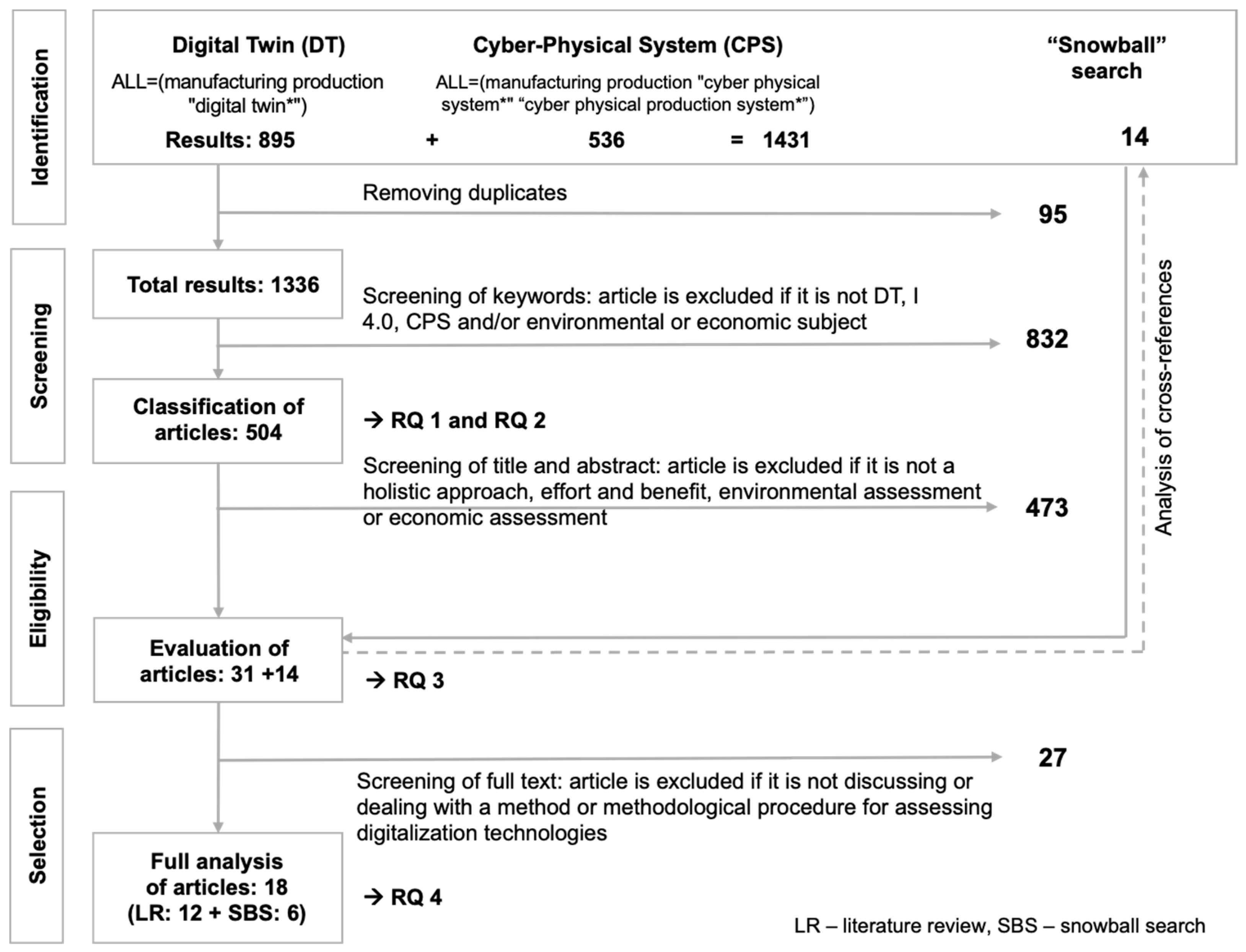
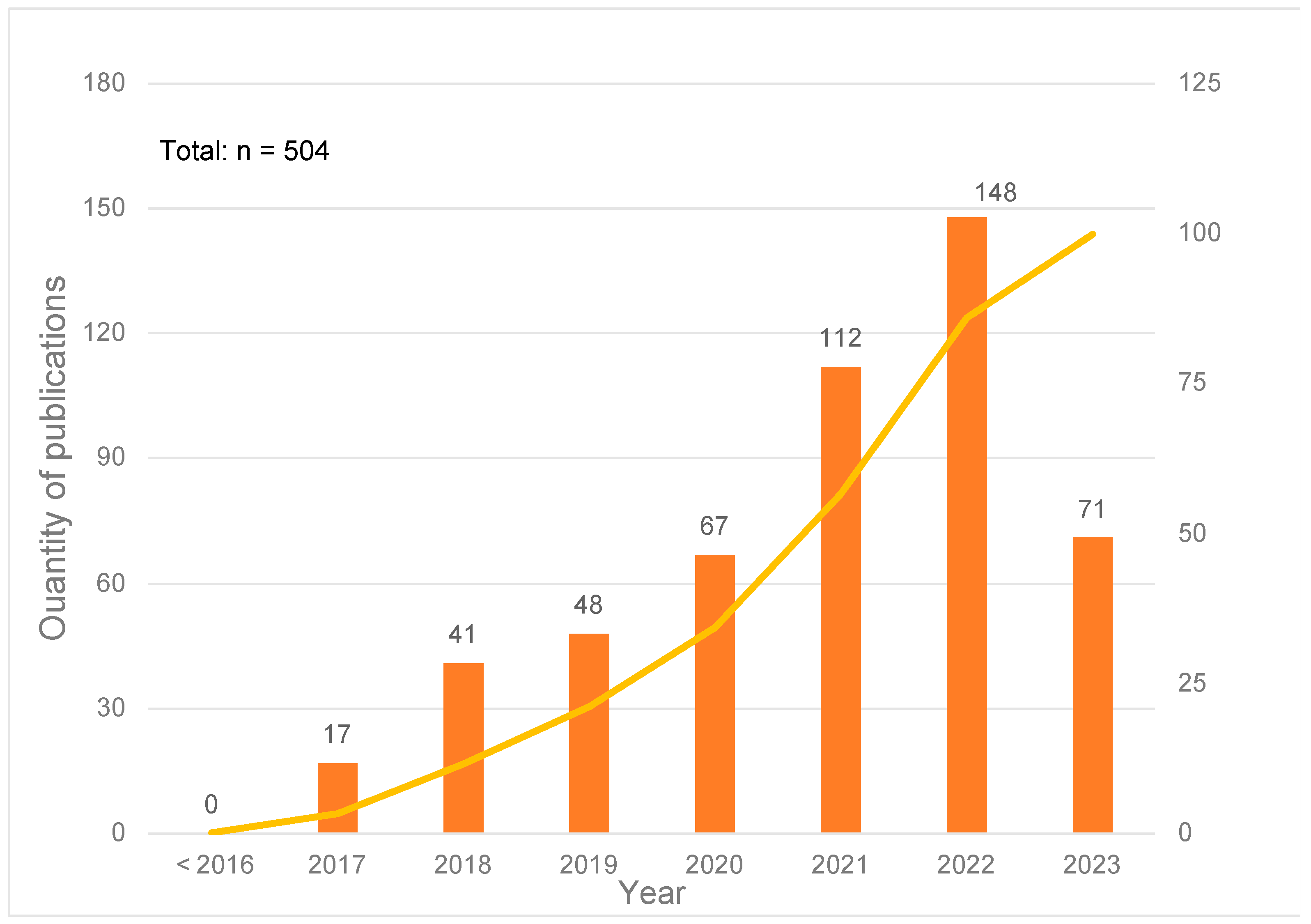



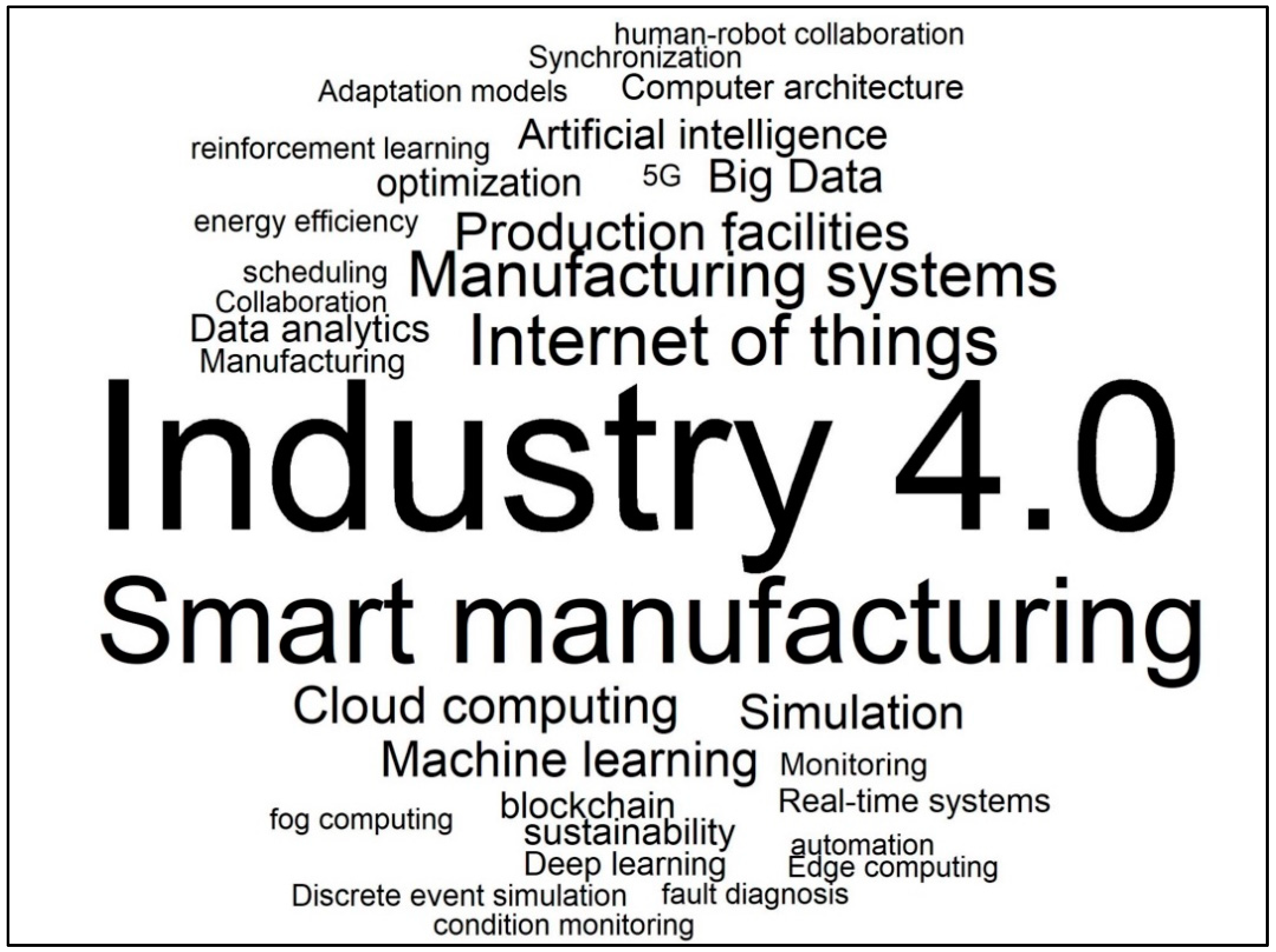

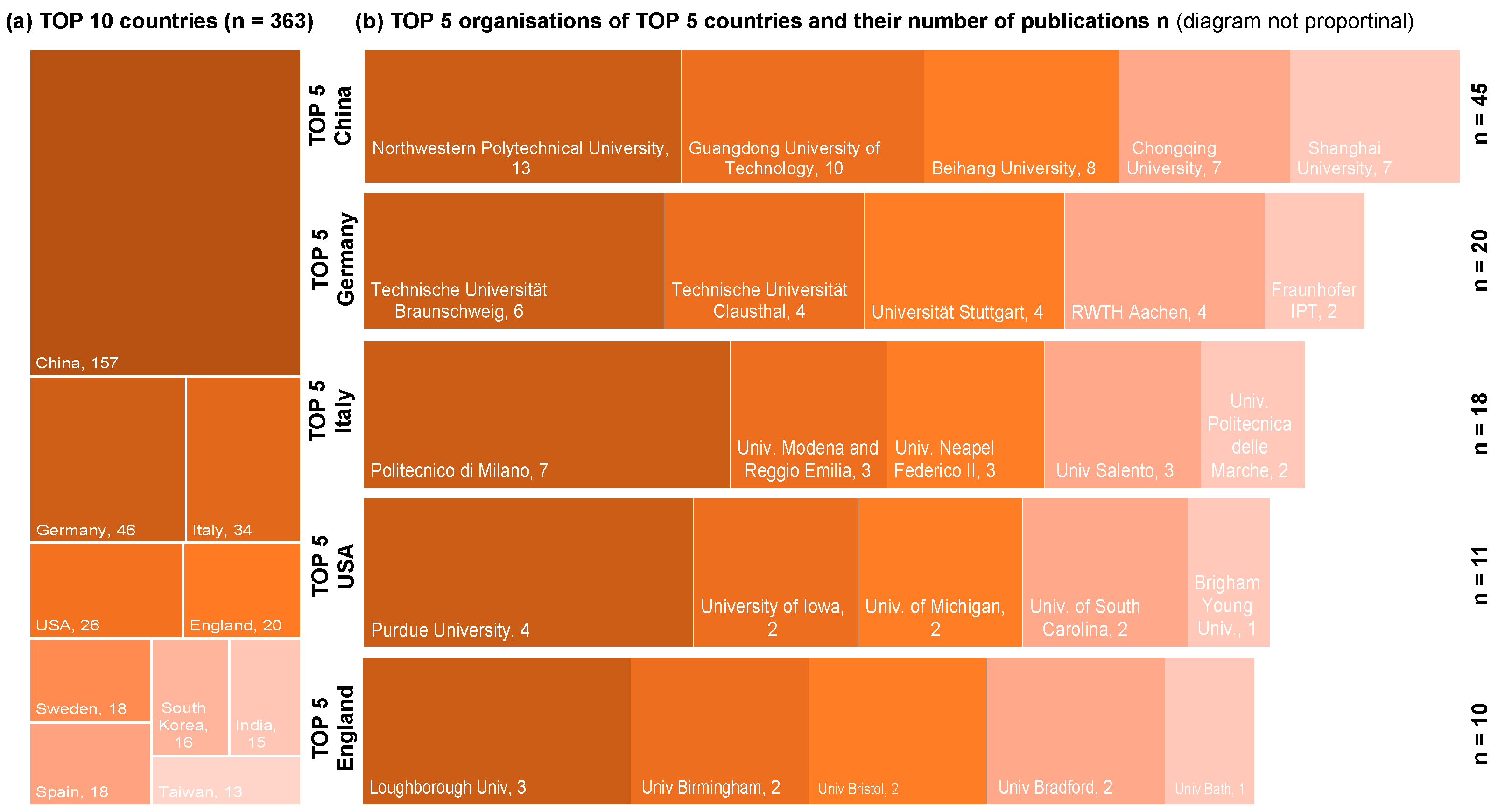

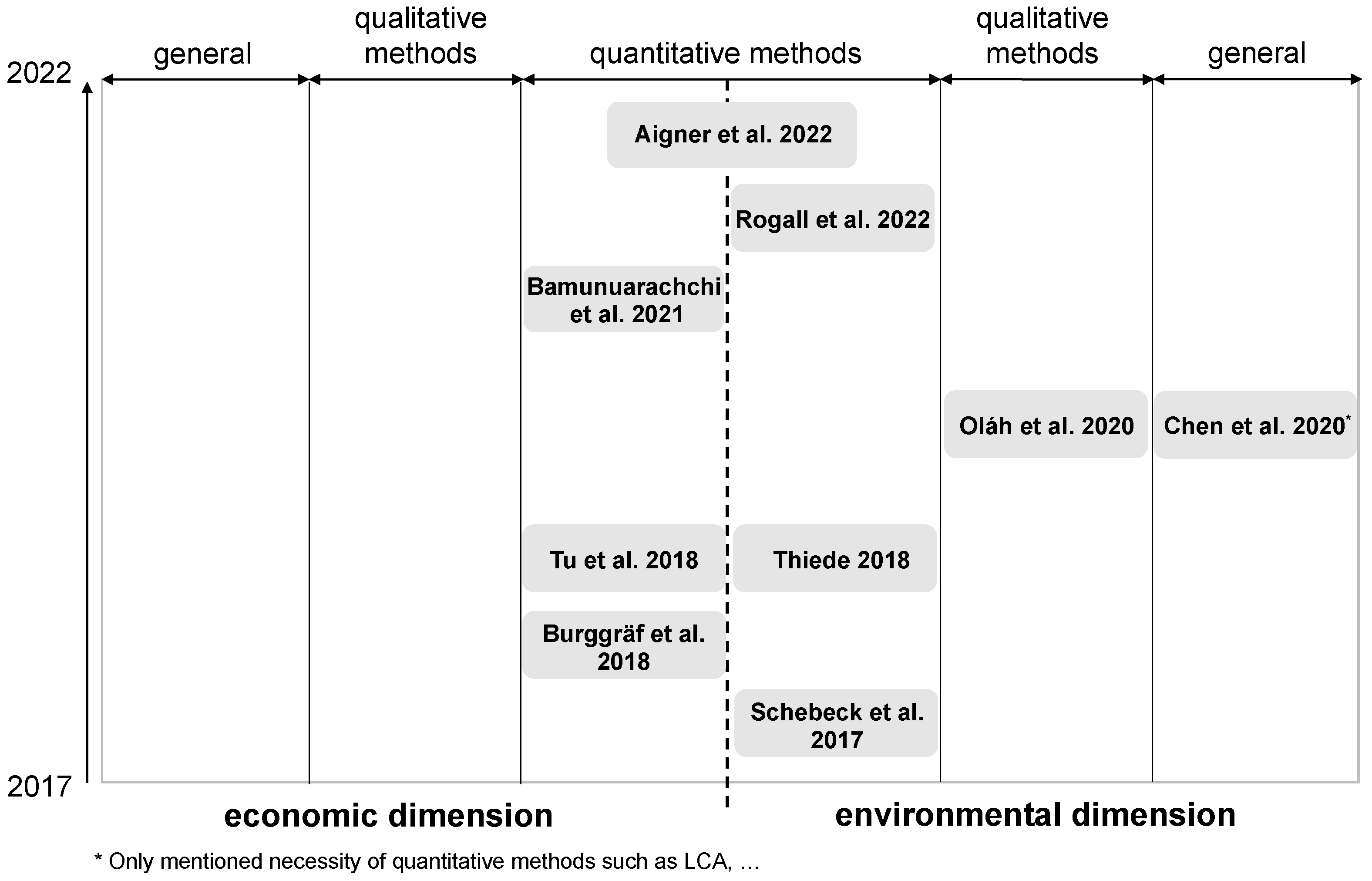
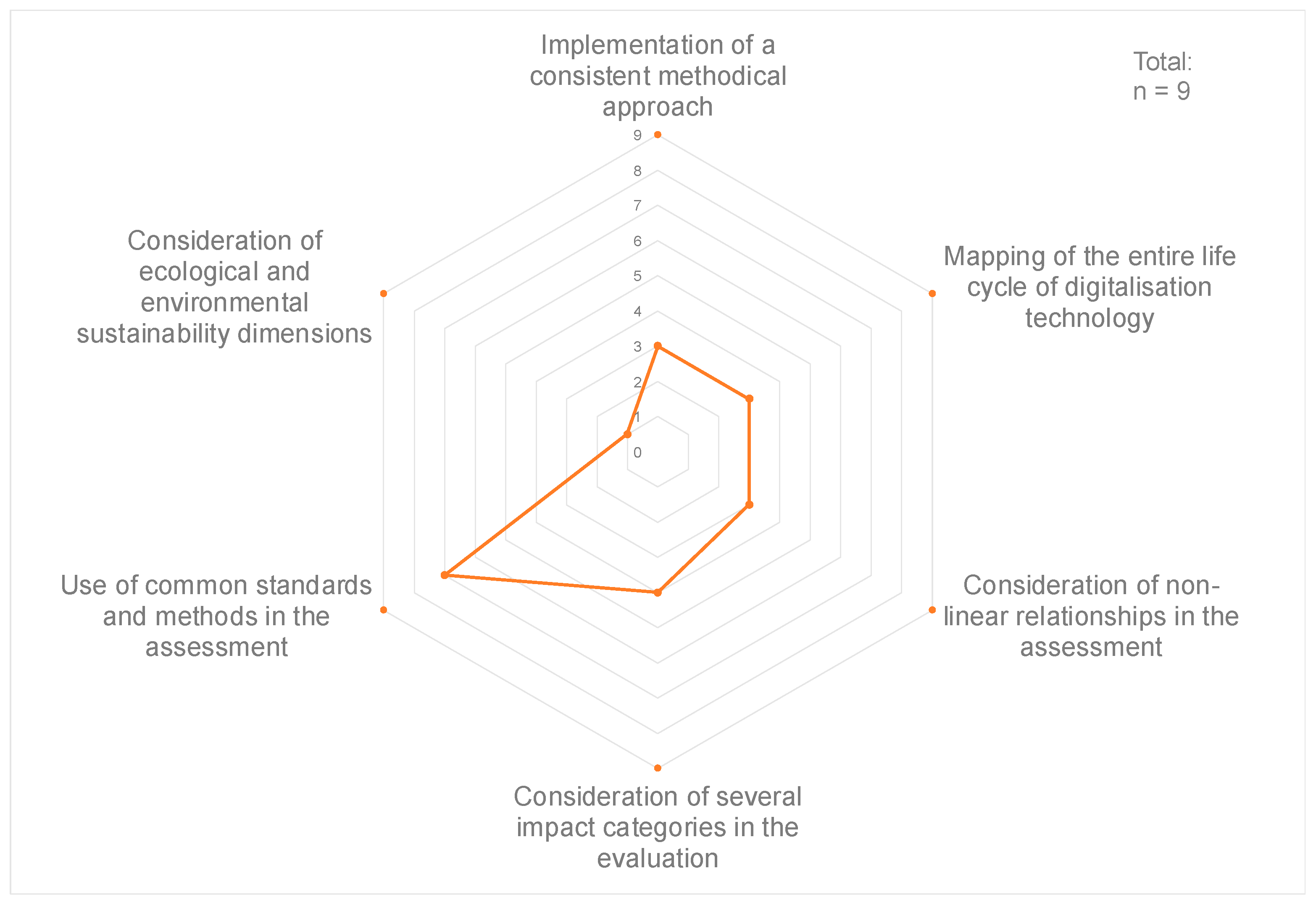
| Terms | Definitions | Sources |
|---|---|---|
| Digitalisation | The term digitalisation describes an ongoing evolution of a general process, whereby analogue data are transformed into digital formats. Digitalisation finds application across various sectors including economy, education and healthcare. In an industrial context, it involves capturing, storing and processing information related to machines and equipment, workpieces and products to enhance process efficiency and explore new possibilities. | [12,25] |
| Industry 4.0 | Industry 4.0 describes the concept of the fourth industrial revolution (Industry 1.0: water and steam power; Industry 2.0: assembly line and electricity; Industry 3.0: automation, computers, and electronics; Industry 4.0: intelligent interconnection of machines and processes; Industry 5.0: interconnection of humans and machines, AI), which entails the integration of digital technologies into industrial processes and production environments and forms the roof over the following mentioned technologies. It encompasses technologies such as the Internet of Things, cyber–physical systems, digital twins, Big Data analytics, and automation to create smart factories and more efficient production processes. | [15,16,17,18,26] |
| DTs | DTs map the physical world as a virtual image (complex digital representation) and can be a part of a CPS. In addition to the function of digitally mapping production machines, DTs are used for the simulation of entire production systems and factories, including their self-description or the mapping of the data basis for machine learning. By using and analysing real-time data from the physical systems, different users are able to view or control the objects as required. The decision-making is facilitated based on the available information from real, simulation and algorithm data. | [27,28,29] |
| CPSs/CPPSs | CPSs are physical objects equipped with an embedded system as well as sensors and actuators. In addition to the hardware, they also include software components and combine the physical with the virtual world through the use of the IoT. The various components are integrated, controlled and monitored by a computational core and affect production processes. A CPPS is a network of several CPSs that together control an entire production system. | [30,31,32] |
| IoT | The IoT connects things and services (industrial equipment) to an IoT platform, networks it with the entire ecosystem of the company and creates a connection between the systems. It also represents the basis for connecting the CPSs. | [33,34,35] |
| Digitalisation- technologies | Digitalisation technologies encompass the tools and devices required to digitalise processes or make them Industry 4.0 capable. For instance, these include the necessary hardware and software in the form of smart sensors and actuators, data transmission systems and programmes for data processing and analysis to build CPSs and DTs and combine the two concepts of DTs and CPSs. | [12,36,37] |
| Terms | Definitions | SDGs |
|---|---|---|
| Economic sustainability | Economic sustainability describes the economic activities of a society in a manner that does not result in losses or disadvantages for future generations. | Industry, Innovation and Infrastructure (9), Responsible consumption and production (12) |
| Environmental sustainability | Environmental sustainability refers to the utilisation of ecosystem structures only to the extent that they can regenerate themselves. | Affordable and clean energy (7), Responsible consumption and production (12), climate action (13) |
| Social sustainability | Social sustainability describes the enduring social development of a state or society, considering intergenerational equity. | Decent work and economic growth (8) |
| Criteria | Included | Excluded |
|---|---|---|
| Data base | Web of Science | Scopus, Google Scholar and any other data base |
| Time period of publication years | <= 2016 to end 2023 * | * the search initially considers studies before 2017, but no relevant publication was found before 2017 |
| Document types | Articles (all, peer-reviewed and open access articles), proceedings and book chapters | -- |
| Science Categories | Engineering Manufacturing, Engineering Industrial, Operations Research Management Science, Computer Science Interdisciplinary Applications, Engineering Electrical Electronic, Materials Science Multidisciplinary, Engineering Multidisciplinary, Automation Control Systems, Computer Science Information Systems, Engineering Mechanical, Green Sustainable Science Technology, Environmental Sciences, Computer Science Artificial Intelligence, Robotics, Multidisciplinary Sciences, Engineering Environmental, Environmental Studies, Management Mechanics | Physics Applied, Telecommunications, Chemistry Multidisciplinary, Chemistry Analytical, Engineering Chemical, Energy Fuels, Mathematics Interdisciplinary Applications, Construction Building Technology, Metallurgy Metallurgical Engineering, Chemistry Physical, Engineering Civil, Physics Condensed Matter, Biotechnology Applied Microbiology, Social Sciences Interdisciplinary and all other specific categories |
| Publishers and publication titles | all | -- |
| Language | English or German | any other language |
| Availability | available online as full text | not available online as full text |
| Countries/ Regions | all | -- |
| Authors | Subject | Assessment Focus | Link to the Topic of Holistic Assessment of Digitalisation Technologies | |||
|---|---|---|---|---|---|---|
| Specific Methodology of Assessment | Literature Research | Case Study | Environmental Assessment | Economic Assessment | ||
| Burggräf et al., 2018 * [62] | X | X | X | Burggräf et al., 2018 present a calculation methodology for the economic assessment of CPS based on established cost accounting models. | ||
| Tu et al., 2018 [64] | X | X | X | Tu et al., 2018 assess an IoT/CPS test environment using a classical cost-benefit analysis. | ||
| Jena et al., 2019 [65] | X | X | Jena et al., 2019 discuss the need to calculate an ecological return on investment or amortisation period. | |||
| Bamunuarachchi et al., 2021 * [72] | X | X | X | Bamunuarachchi et al., 2021 develop a comprehensive cost model for the evaluation of I 4.0 applications in the development phase of digitalisation technologies (cost-efficient development). | ||
| Schebeck et al., 2017 [12] | X | X | X | A methodological approach for the environmental assessment of digitalisation technologies is proposed by Schebeck et al., 2017. | ||
| Bonilla et al., 2018 * [61] | X | X | Bonilla et al., 2018 recommend the development of a procedure for the quantitative environmental assessment of digitalisation systems. | |||
| Thiede 2018 * [63] | X | X | X | Thiede 2018 presents a methodology for the environmental assessment of CPS and demonstrates the need to integrate an economic assessment. | ||
| Vrchota 2020 [70] | X | X | Vrchota 2020 indirectly refers to the need for a holistic assessment when using digitalisation systems. | |||
| Chen et al., 2020 [66] | X | X | X | Chen et al., 2020 discuss the general effects of digitalisation on environmental sustainability and examine the question of whether these are positive or negative. | ||
| da Silva et al., 2020 * [82] | X | X | Da Silva et al., 2020 describe the problem that potential (energy) savings through I 4.0 technology are limited due to the availability of critical raw materials required for its production. | |||
| Lukasik and Stachowiak 2020 [67] | X | X | Lukasik and Stachowiak 2020 not only point out the advantages, but also the problem of ecological sustainability. | |||
| Oláh et al., 2020 * [68] | X | X | X | Oláh et al., 2020 carry out a Literature review and a scenario-based analysis (qualitative assessment criteria of energy and material consumption). | ||
| Sony 2020 [69] | X | X | Sony 2020 indirectly points to the need for an economic assessment (profitability calculation) of digitalisation systems and notes that there is a need for further research into the environmental impact of digitalisation systems. | |||
| Badakhshan and Ball 2021 [71] | X | X | Badakhshan and Ball 2021 discuss and recommend analysing not only the advantages of DT but also the problems that arise from its use. | |||
| Jamwal et al., 2021 [74] | X | X | Jamwal et al., 2021 refer to the problem of costs and benefits when using digitalisation technology. | |||
| Rogall et al., 2022 [75] | X | X | X | Rogall et al., 2022 extend the approach of Thiede 2018 with a method for identifying environmentally relevant influencing parameters of CPS. | ||
| Aigner et al., 2022 [76] | X | X | X | X | Aigner et al., 2022 analyses the environmental and economic profitability of retrofitted I 4.0 solutions (retrofit measures, CPPS) by comparing production with/without digitalisation technology of a reference component (or various retrofit scenarios). This deepens the approaches of Thiede 2018 and Rogal et al., 2022. | |
| Pater and Stadnicka 2021 [73] | X | X | X | Pater and Stadnicka 2021 discuss the need for further research to evaluate the use of DT. | ||
| 9 | 10 | 8 | 14 | 6 | ||
| Analysis Criteria | Digitalisation Criteria | Economic Criteria | Environmental Criteria | Used Data Sources | Use Case (Case Study) | Decision Criteria | Impact Category |
|---|---|---|---|---|---|---|---|
| Description | Which digitalisation technology is considered (CPS/CPPS/IoT/DT/other)? | Which economic assessment takes place and which criteria are evaluated? | Which ecologic assessment takes place and which criteria are evaluated? | Which sources are used to obtain the data for the assessment? | Which use case is applied? | Which criteria are used for evaluation or to support decisions? | Which evaluation basis for the selected methods is used? |
| Burggräf et al., 2018 [62] | CPS | return on investment (ROI) cost-model | ----- | directly from the case study | production environment (focus material flow) | ROI-Model | costs |
| Tu et al., 2018 [64] | CPS/IoT | cost-benefit-analysis | ----- | measured data and data form the case studies | experimental use case (demonstrator) | ratio of benefit to cost | costs |
| Bamunuarachchi et al., 2021 [72] | I 4.0 applications | cost model | ----- | directly from the case study | logistic process | defined cost factors | costs |
| Schebek et al., 2017 [12] | I 4.0-Technology | ----- | LCA method | directly form practice (case studies) | different I 4.0 scenarios (real production scenarios) | ratio of benefit to effort | energy resources, ecosystem services (CO2), raw materials |
| Thiede 2018 [63] | CPPS | ----- | LCA method | data form different studies to this theme and LCA-Databases (like Eco invent) | different production systems | quotient of output to energy and resource input | global warming potential |
| Chen et al., 2020 [66] | digitalisation technology (I 4.0-Technology) | ----- | LCA approach | literature study | ----- | relationship between effort and benefit of the technologies and products | energy, resources (raw materials) |
| Olah et al., 2020 [68] | I 4.0-Technology (focus CPS) | ----- | scenario-based analysis (qualitative assessment) | literature study | ----- | resource consumption and environmental impact | material use, energy use, waste, GHG-emissions |
| Rogall et al., 2022 [75] | CPPS | ----- | LCA method | LCA database and from measured data in the case study | prototype process (3D-Prinitng) | energy and material consumption | global warming potential |
| Aigner et al., 2022 [76] | CPPS (retrofitting solutions) | calculation based on investment | LCA method | directly from the case study, from databases and other studies | machining process (metal cutting machine) | effort and benefit according to the developed method | global warming potential, cumulative energy expenditure, cumulative raw material expenditure, water consumption, land take, resource criticality |
Disclaimer/Publisher’s Note: The statements, opinions and data contained in all publications are solely those of the individual author(s) and contributor(s) and not of MDPI and/or the editor(s). MDPI and/or the editor(s) disclaim responsibility for any injury to people or property resulting from any ideas, methods, instructions or products referred to in the content. |
© 2024 by the authors. Licensee MDPI, Basel, Switzerland. This article is an open access article distributed under the terms and conditions of the Creative Commons Attribution (CC BY) license (https://creativecommons.org/licenses/by/4.0/).
Share and Cite
Tomaschko, F.; Reichelt, L.; Krommes, S. Digitalisation of Manufacturing Systems: A Literature Review of Approaches to Assess the Sustainability of Digitalisation Technologies in Production Systems. Sustainability 2024, 16, 6275. https://doi.org/10.3390/su16156275
Tomaschko F, Reichelt L, Krommes S. Digitalisation of Manufacturing Systems: A Literature Review of Approaches to Assess the Sustainability of Digitalisation Technologies in Production Systems. Sustainability. 2024; 16(15):6275. https://doi.org/10.3390/su16156275
Chicago/Turabian StyleTomaschko, Florian, Lukas Reichelt, and Sandra Krommes. 2024. "Digitalisation of Manufacturing Systems: A Literature Review of Approaches to Assess the Sustainability of Digitalisation Technologies in Production Systems" Sustainability 16, no. 15: 6275. https://doi.org/10.3390/su16156275






